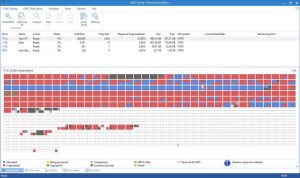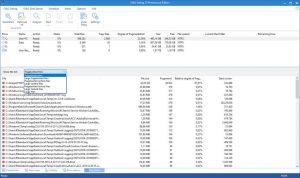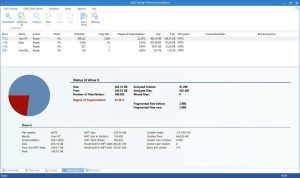O&O Defrag 23 Software With SSD Optimization Solid/Complete
$30 for single licence, $50 for 5 computers
This is a Press Release edited by StorageNewsletter.com on September 13, 2019 at 2:04 pmSSDs have advantages: they’re quick, small, and can save volumes of data.
Click to enlarge
And they supposedly can’t be defragmented. But that’s not true because as is the case with any system that wants to save files quickly, files will sooner or later wind up scattered across the entire storage area. Up until now, the methods available for restoring an SSDs original speed have been pretty basic.
O&O Defrag 23 introduces the solid/complete method, developed by O&O Software GmbH, which achieves an increase in performance.
Click to enlarge
The problem: every file system is fragmented. This means that over time, files will no longer be filed consecutively but, instead, be scattered across the computer’s entire storage area. This can’t be avoided because files are subject to constant changes. In order to avoid fragmentation, you’d need to know all the newly arriving files as well as all changes and deletions in advance. This is simply not possible.
This problem doesn’t just apply to HDDs but to SSDs as well. Over the course of time SSDs save file fragments over more memory cells than are necessary. This leads to a continuous slowing down of the read and write processes, just as we experience on HDDs. The SSD controller tries to counter this phenomenon on a rudimentary level but is unable to do so on account of its not having an overall view of the data structure.
This is where O&O Defrag 23 goes to work with its method: scattered file fragments will be reconnected and saved in fewer memory cells. This leads to fewer read and write accesses to these memory cells. The result is the SSD running faster and its life expectancy increased on account of reduced read and write accesses.
Along with the solid/complete, the existing solid/quick method has been extended: it is now faster than complete and suitable for an occasional faster defragmentation.
“Since so many customers are still using them, we’ve also integrated the new solid/complete for HDDs“, says Olaf Kehrer, MD, O&O Software. “O&O Defrag automatically recognizes the kind of disk being used and then decides on the right technology to apply. Positive side effect: as a result of this method being so very resource and hardware friendly on both SSDs and HDDs, it’s now possible to achieve an optimal increase in performance with very little effort.”
To make the distinction between the data saved on HDDs and SSDs even clearer for users, the company redesigned the HDD block view especially for SSDs: the SSD memory blocks are now displayed there.
Click to enlarge
O&O Defrag supports all versions of Windows 7, 8.x and 10
O&O Defrag 23 Professional Edition is compatible with Windows 7, Windows 8.x and Windows 10. It has been optimized for low processor and memory capacity in older systems. A Server Edition of the version 23 will be available shortly for Windows Server versions.
Features
The new defragmentation method Solid/Complete: SSDs save file fragments on more memory cells than needed. The resource and hardware friendly Solid/Complete method defragments these file fragments so that only the number of memory cells required will be used for reading and writing in the future. Solid/Complete can be used on SSDs ands HDDs.
Solid/Quick
This method designed for SSDs can provide them with a surface optimization. This method is faster than Complete.
O&O Defrag
The Stealth and Space defragmentation methods have been optimized for the fastest possible defragmentation, while the Complete methods allow for a more complete defragmentation. This of course, requires more time and memory. The optimal utilization of existing storage space also prevents any new fragmentation. All methods can be applied to any drive, including Volume and Stripe Sets, and guarantee maximum reliability.
Block view of SSDs: to visualize the difference between saving data on an SSD and a HDD, the block view illustrates the logical construction of an SSD.
Statistics: O&O Defrag provides information about the number of files and folders that were defragmented as well as the number of bytes that were moved in the process (so-called Terabytes Written-TBW). This information is needed for a number of reasons, for instance, the guarantee on an SSD.
O&O DiskCleaner: Searches for and removes temporary and superfluous files that use up memory and increase fragmentation. It also increases the data protection and security of a system as such files often contain private content (e.g. Thumbnails, document copies, email drafts, Dumps) as copies.
Supporting vertical contrast modes: The current version has improved the high contrast mode to facilitate recognizing objects on the screen.
Variable DPI settings: O&O Defrag adapts optimally to the selected DPI setting.
User interface: User interface went through a general overhaul to make the intuitive use easier.
Shorter defragmentation times: Several drives can be defragmented simultaneously. In addition, the algorithms have been substantially accelerated, reducing the time required for a defragmentation by up to 35%.
Automatic defragmentation: Automatic defragmentation is enabled by default after the installation of O&O Defrag and optimizes the disks in the background without slowing down the performance of the computer. Special procedures are initiated here to monitor the disk activity and ensure optimal use of system resources.
Optimizing VMs und SANs: It optimizes the actual memory allocation for VMs and SANs. it is useful for the host system of VMs to place the virtual storage areas that are created in the file optimally.
Evaluation and analysis: Whenever the program is started, a manual analysis of all drives can be made and the level of fragmentation for each drive is displayed. It is also possible to display the most heavily fragmented files as well as the physical location of fragmented files on the HDD. A dynamic block view appears during defragmentation and with the help of a before and after view, the user can get a total picture of the system’s optimization.
History: O&O Defrag has graphics that display which defrag action has led to which optimization success.
Power management for netbooks and notebooks: As soon as mobile systems such as notebooks or netbooks are no longer connected to external power sources, the defragmentation is interrupted so that the battery power is available for mobile workers.
Zone filing on drives: A logical separation of data into performance-critical and non-critical files is conducted through an alternative setting which divides drives into so-called zones. Files are sorted based on their use and access frequency and moved into appropriate zones. For example, system and program files that need to be accessed quickly are separated from other data such as documents and downloads. Fragmentation is prevented intelligently through the separation of files written rarely or frequently. This logical arrangement shortens the duration of the system or program start, and also prevents fragmentation of program files from ever occurring.
Automatic update: O&O Defrag automatically checks if newer program versions are available and so can guarantee that defragmentation is always done using.
Pricing and availability:
-
A single O&O Defrag 23 license costs $29.95.
-
A license valid for use on up to 5 computers costs $49.90.
-
The O&O Defrag 23 Server Edition, optimized for use in companies, will be released in the near future.
-
All prices include 19% VAT where applicable.
Download a free 30-day trial of O&O Defrag 23 Professional Edition

















 Subscribe to our free daily newsletter
Subscribe to our free daily newsletter

